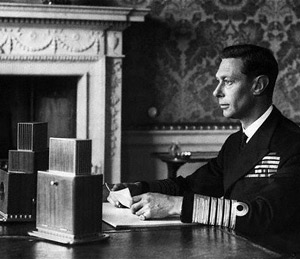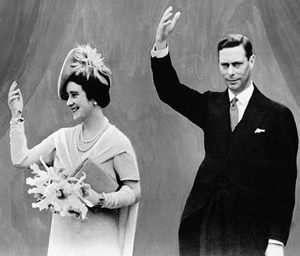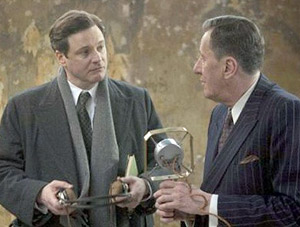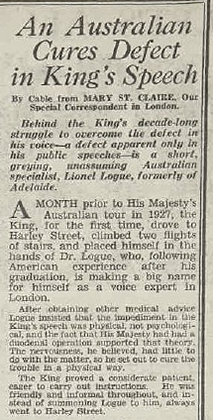‘The King’s Speech’ – The Craft and the King
There is no mention of Freemasonry in the Oscar-winning film that tells the true story of how King George VI battled a confidence sapping stammer, writes Masonry Today journalist, Paul Hooley. ‘The King’s Speech’ has been critically acclaimed as one of the finest motion pictures of recent years and has renewed the public’s interest in, and affection for, King George VI, who reigned on the throne of Great Britain through its darkest years from 1936 to 1952.
The movie, which chronicles the constitutional crisis created by Edward VIII’s abdication, George’s take-over and his struggle to overcome his severe stammer, focuses on the moving relationship between the King and speech therapist, Lionel Logue, (see Logue Famous Freemasons A-L) which had such a positive ending: the King and the commoner remaining firm friends for life.
What the film fails to mention, however, is that both men were members of the Craft; and that the King believed Freemasonry was forefront in assisting him to overpower his speech impediment – a disability that rarely surfaced whenever he performed Masonic ritual. Logue, who had been the Master of St. George’s Lodge, Western Australia, was also speech therapist to the Royal Masonic School.
KING GEORGE'S LOVE OF FREEMASONRY
After service with the Royal Navy in the First World War, he was initiated in December 1919 into Navy Lodge, No. 2612, his grandfather, King Edward VII, having been founding Master. On that occasion he noted: “I have always wished to become a Freemason, but owing to the war I have had no opportunity before this of joining the Craft.” From that moment he became a most dedicated and active Mason. He was invested under his real name as Albert, Duke of York in 1920 and the following year installed as permanent Master of Navy Lodge. He joined other lodges and degrees and was appointed Senior Grand Warden of the United Grand Lodge of England in 1923.
His father, George V, died in January 1936 and was succeeded by his eldest son Edward, who had been initiated (also in 1919) into the Household Brigade Lodge, No. 2614. But before the year was out Edward had abdicated. Of that momentous occasion of change King George VI later wrote: “On entering the room I bowed to him as King… when [he] and I said goodbye we kissed, parted as Freemasons and he bowed to me as his King.”
Protocol required George as the new King to resign his Masonic affiliations, largely against his will, when it was suggested, however, that a new position of Past Grand Master be created especially for him, he immediately accepted, declaring: “Today the pinnacle of my masonic life has been reached.”
THE VICTORY STAMPS
Following World War II, King George wrote that: “Freemasonry has been one of the strongest influences on my life” and in collaboration with engraver Reynolds Stone helped create a postage stamp, part of the ‘1946 Victory Issue,’ which is filled with Masonic symbolism.
The 3 penny Victory Stamp was widely praised for the “strength and simplicity of the design.” It depicts the King’s head in the East, his eyes firmly fixed on illustrations of a dove carrying an olive branch (representing peace and guidance), the square and compasses (configured in the second degree) and a trowel and bricks (the sign of a Master spreading the cement that binds mankind in brotherly love).
The graphic on the stamp appear in white, the colour of purity, out of purple, the colour of divinity. The three coupled illustrations are surrounded by a scrolled ribbon made up of five figure threes – sacred numbers in Freemasonry – and was the unusual positioning of the wording meant to represent two great pillars? By its name and intention, the stamp proclaimed victory over evil, yet by its appearance it expressed compassion and hope. George VI once stated: “The world today does require spiritual and moral regeneration. I have no doubt, after many years as a member of our Order, that Freemasonry can play a most important part in this vital need.”
The Victory Stamp captured those words in a graphic representation that also expressed the King’s belief that the building of a new and better world could best be achieved by adhering to the principles of the square and compasses.
MAINTAINING VALUES


King George suffered utter anguish prior to making any speech in public, but felt duty-bound to try.
He reinforced those thoughts in 1948 in an address he gave to Grand Lodge: “I believe that a determination to maintain the values which have been the rock upon which the Masonic structure has stood firm against the storms of the past is the only policy which can be pursued in the future. I think that warning needs emphasising today, when men, sometimes swayed by sentimentality or an indiscriminate tolerance, are apt to overlook the lessons of the past. I cannot better impress this upon you than by quoting from the book on which we have all taken our Masonic obligations: ‘Remove not the ancient landmark, which thy fathers have set.’”
Footnote: A simply captivating film, ‘The King’s Speech’ won the Academy Award© for Best Picture of 2011. For his portrayal of King George VI, Colin Firth won the coveted Best Actor Oscar©, along with Academy Awards for Best Director (Tony Hooper) and Best Original Screenplay (David Seidler).




